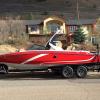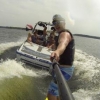Search the Community
Showing results for tags 'winterizing'.
Found 4 results
-

Winterizing enzo 240+
Willieb posted a topic in Centurion Boat Maintenance, Performance, Troubleshooting
I want to learn to winterizing my 2011 centurion Enzo 240+. Any online videos or other resources to guide me? -
Here's how I winterized my SV233 with the H5 engine. I owe a big thanks to Stoked for already providing a lot of this information in a previous post. Steps I took: 1. Changed oil and filter using this: https://www.amazon.com/Jabsco-17850-1012-Premium-Marine-Changer/dp/B001CX0WX4 You will want to warm up your engine for several minutes to get the oil warm enough to flow. This oil changer works by putting the clear plastic tube down the oil dipstick tube. Takes probably about 10 minutes to empty with warm oil. Place a ziplock bag (pretty sure I used the gallon size) over the filter when removing the filter to catch all of the oil and not have it drip into your boat. 2. Pull all your blue drain plugs. There are 9 on the H5. All of them are pretty easy to see/find with the exception of the V drive. That one is hidden. Here are some photos: There are 3 on the port side; 5 on the starboard side; and 1 on the V drive. I screwed all of the blue plugs into the holder that's attached to one of the engine dividers to make sure I got them all. 3. Pull your heater lines where they are connected to the engine and either blow out with an air compressor using a blow gun (don't get carried away with too much air; the heater cores are just tubes) or use a shop vac to blow them out (thanks H2O King!). 4. Now put all of the blue plugs back into where you pulled them out of. Be gentle with these putting them back in. It's easy to cross thread them and screw them up. Go easy and you won't have any issues. 5. Add 5-6 gallons of antifreeze to the engine. I ended up adding a T kit to my raw water intake to make this easy. Here's what I used: More to follow in the next post.
- 14 replies
-
- 2
-

-
- H5
- winterizing
-
(and 1 more)
Tagged with:
-
I did the dirty deed today. We have no time left to get out, so time to put the boat away and dig out the surfboards as the storms will be coming up the east coast soon. I'm a big fan of doing as much of my own work as possible on my boat, it's the best way to get to know it, since I'm new to the PCM 409 and couldn't find a DIY guide, I figured I'd post one here from the information I gathered from the manual, mainly so I can follow it again next time. This is for a 2015 FS33, but it should be similar for other boats with the 409. First the parts I ordered per the winterizing instructions in my manual: Oil Filter PCM R077001: http://www.bakesonline.com/detail.aspx?ID=2568 Pre Fuel Filter PCM R077019: http://www.bakesonline.com/detail.aspx?ID=2925 Fuel Filter Element PCM RP080026: http://www.bakesonline.com/detail.aspx?ID=744 Piece of Mind (We live on a brackish bay with some salt in the air): http://www.bakesonline.com/detail.aspx?ID=1627 Stabil 5 quarts of SAE 15W-40 (I went with Rotella from the local marine supply) 5 gallons of antifreeze I also have, but not necessary to the process: Bucket Ape: http://bucketape.com/index.php?option=com_content&view=article&id=694%3Awinterizing-your-boat-cheap-and-easy&catid=12%3Aadhesives&Itemid=18 Electric oil extractor (I had a hand pump last year, ain't doing that again...): http://www.amazon.com/gp/product/B001CX0WX4?psc=1&redirect=true&ref_=oh_aui_detailpage_o02_s00 Kevlar Sleeves, if you've never worked around a boat motor before, you want these, there are sharp clamps everywhere and you'll slice up your forearms: http://www.amazon.com/gp/product/B0035X8L96 First thing I did was dump in 7 ounces of StaBil, that way when I run it later it can work through the system. I then removed the PnP bags, the shelves, and the engine walls to give myself some more room to maneuver. Next I did the fuel filter, this guy: Using a strap wrench I got him lose, it came off very easy and the new one went on just as easy. I used the T-9 on the rubber seal before putting on the new one. One thing to note, I hadn't run the boat in 2 weeks so I didn't need to relieve pressure in the fuel line. If you just ran it, slowly unscrew the filter. Next Fuel Cell Filter. You can find him on the starboard belt side of the engine. This was pretty freakin hard for me to get too, I had to go fetal in the locker which wasn't easy for me, I'm a 6'4" and definitely got stuck for 15 seconds at one point. Following the manual it says to remove the hose at the bottom, take out the drain and disconnect the wires (one on the bottom, one on the top). The only thing I did was disconnect the wires. The drain plug according to the manual was supposed to be 7/16 but it was way larger than my largest wrench which is a 3/4. I tried to take off the hose, but it was on there very very tight. So I removed the bolt from the clamp at the top and wiggled the canister down. Once I had it off I poured some of the gas out. Getting the filter element out was pretty hard for me, my hands wouldn't fit down far enough into the canister. I used needle nose pliers to get it to the top, then had to finagle it to remove it. I put the new one in, changed out the o-rings (there were two of them, just above my finger): I put the canister back on (make sure it is completely even all the way around, otherwise the compression clamp won't seat right). Also make sure you reconnect the two connectors, it will greatly confuse you later when the boat won't start if you don't. I'm glad I changed this, I almost didnt, I only have 60 hours on the boat and this is what the old one already looked like: With the fuel system back together, it was time to get the engine warmed up. I have a flush kit installed, so I connected my hose up and turned the water on. I then primed the fuel pump (after connecting the wires) by turning the ignition on for 5 seconds, off for 10 seconds, then back on. It fired right up. I let it run for 10 minutes till it got above 160 degrees. While it was warming up, I winterized the ballast. I removed the overflows from all of the PnPs and manually blew the water out with my mouth. I then removed the fills and one at a time I hit Override Drain on each PnP and while it was running I poured antifreeze directly into the fill hose. This took an entire gallon for all three. By this time we were warm. I pulled the dip stick and measured it against my oil extractor hose, I added an inch and marked it with black tape so I knew how far to insert it into the dipstick tube. I did not use the oil drain hose because 1) I couldn't find it and 2) even if I did find it, they installed the bilge pump directly in front of the drain, so I wouldn't have gotten it out without removing that. So I used my extractor instead. This took less than 10 minutes. Once it was finished I replaced the dip stick and used my strap wrench to remove the oil filter (didn't take a photo, you really can't miss it). Careful with this guy, he's filled to the top with insanely hot oil. I used some of the old oil to seat the rubber seal on the new filter and screwed it in. I then added 5 quarts of oil and that was that. I have mixed feelings about the next step, removing the plugs and draining the system. I run antifreeze through the system, so it seems like a silly step. I'm open to arguments about it, but for now I did it. When I removed each plug, I cleaned it off and rewrapped it with teflon tape. If you follow the Water Flow Diagram from your manual, the first one I removed was Plug 3 on the bottom right of the heat exchanger: Plug 3 is also a Zinc Anode, it should be about an inch and a half long, according to the manual you need to change it out once you're half that length. Next was plugs 4 at the bottom of the exhaust manifolds on either side, these little jerks aren't bolts: They are on the bottom of each exhaust housing, conveniently labeled Raw Water Drain. These take a 3/4 socket to unscrew, luckily I had an adapter: Next plugs 5 up top on the exhaust corners on both sides: And now the hidden plug, Plug 6. It's under the V-Drive and is the same jerky plug as Plugs 4. You can't see this guy, just feel around for him: And finally the oscar the grouch plug, Plug 7. In the future I will not be removing this one, he's silly and insanely hard to get to. It's blurry but he's at the top of the blue hose, just on the other side of the clamp on the right. He's against a mounting bracket that nearly makes it impossible to get to him, also two drops of water came out when I finally did get him out: Finally I checked out the thermostat per the manual, it's this guy behind the heat exchanger (I took the top plastic off the engine): He came out easy enough, but I had a BEAR of a time getting him open. I had to use large channel locks and a large adjustable wrench a lot, and I mean a lot, of leverage. There is supposed to be a screen inside that needs to be cleaned, mine did not have said screen and mine was also installed upside down. Given the damage my channel locks did to the outside, and the fact I could not even get it anywhere near as closed as it was when I pulled it, I'll probably order a new one. Now we're at the part that made me question draining everything. I have the Bucket Ape, so I connected it to my flush kit, filled the bucket with 4 gallons of antifreeze and started her up. No antifreeze was being sucked through. Draining the entire system left no water in it to prime the water pump. So I had to rehook up my water hose and refill the system just so that it would pull antifreeze through. I didn't have this problem on my black scorpion, but I did here. So why did I just drain everything?? I think in the future, I'll just run antifreeze through, it I wasn't going to do that, I could see draining everything. Now finally pulling the impeller. If you thought it was bad getting to the fuel cell, you haven't seen anything yet. Remove the plastic top and the plastic protector that is covering the belts. There are two bolts, one on top and one under the closed system overfill bottle. Take the belt off of using the tensioner. This guy is 16mm and under the over flow bottle, you have to push it away from you as hard as you can and remove the belt when there is enough slack. Here he is, my wrench is pointing at him, you can see we're right below the overflow bottle: Once the belt is loose, switch over to the other side. Take a 11mm socket and extension with you and curl all the way up under the locker to your head almost hits the back of the boat. I'm going to be sore for days after doing this part. We're looking for the pulley with 3 allen bolts on it: Don'e remove the allen bolts!! Instead rotate the bulley till you can access the three bolts behind it via the three openings in it, there's small guys but completely loosen them (don't worry, they can't fall). Here's a shot of one of them: Once they are all loose, pull the pulley off, this will also separate the water pump and you'll be able to pull the impeller. Put this guy back on and take a look at your impeller. If he looks alright, store him somewhere that you'll remember in the spring as well as a place that will remind you to put him back in in the spring. Mine didn't look so hot, he had some weird grooves: So I'll be ordering a new one this week, and throwing it on the dash so I remember. All in all I have mixed feelings about doing this winterization versus when I used to do it for my Avy. I'm glad there are no more blue plugs that strip every time you try to put them in, but I don't like all the different plug types of the 409. The water pump was easier to remove on the 409, in theory, but WAY harder to get to. I'm also a little worried about how I couldn't get antifreeze through the system until I filled it water. I'm a little less concerned because it will be indoors in a climate controlled warehouse. But, with the impeller out I'll probably get a low flow pump and pump and push another 2 gallons through the system for piece of mind (even though there is already 4 gallons in it). Things I didn't do: flush the closed system. the manual said not to, I did however top off the overflow bottle. I didn't flush the heater. Shane said that on the 409 it is apart of the closed system. I didn't change the transmission fluid. The manual said not to, to only change it if inspecting it shows debris. I checked mine and it looked good and was full. I did everything else the manual asked of me I think this is going to be my winterization plan: I'm going to winterize it myself every other year and let the professionals do it the in between years. This is my first brand new boat, so I want to make sure it gets everything it needs, especially if I can't give it to her...
-

Winterizing a zr409 engine
Sfb330 posted a topic in Centurion Boat Maintenance, Performance, Troubleshooting
So I just purchased a 2013 sv244 with 250 hours. I read the pcm manual regarding winterizing. It has a raw water flow page that was very informative. Essentially you pull out plugs at 7 locations and the water all drains out. The remainder of the cooling system is sealed with antifreeze like a normal vehicle engine. I used a hydrometer to check that the antifreeze was good to -35 degree. I pulled out all the raw water plugs. Fogged the cylinders by pulling out the spark plugs. Filled the tank and added stabilizer. Drained the large low pressure fuel cartridge because it says that water can get collected in it. Took out the batteries. I will change the oil, oil filter, tranny fluid, and fuel filter in the spring. Should this be sufficient for for the winter (we live in Canada)? The boat has 6 pumps for the ballast tanks. The hoses coming in and out of each pump are see through and you can see that there isn't any water in the hoses. I figured this should be ok. Is this a mistake?- 6 replies
-
- Winterizing
- PCM zr409
-
(and 1 more)
Tagged with:



